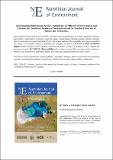Files in this item
An analysis of the risk of collisions between aircraft and vultures in Namibia
Item metadata
| dc.contributor.author | Hauptfleisch, Morgan | |
| dc.contributor.author | Knox, Nicki | |
| dc.contributor.author | Heita, P | |
| dc.contributor.author | Aschenborn, O. | |
| dc.contributor.author | MacKenzie, Monique Lea | |
| dc.date.accessioned | 2020-06-01T09:30:02Z | |
| dc.date.available | 2020-06-01T09:30:02Z | |
| dc.date.issued | 2020-05-28 | |
| dc.identifier | 268264392 | |
| dc.identifier | 33dfc54c-53da-4ac0-b343-84ab2225825f | |
| dc.identifier.citation | Hauptfleisch , M , Knox , N , Heita , P , Aschenborn , O & MacKenzie , M L 2020 , ' An analysis of the risk of collisions between aircraft and vultures in Namibia ' , Namibian Journal of Environment , vol. 4 , no. A , pp. 41-49 . < http://www.nje.org.na/index.php/nje/article/view/volume4-hauptfleisch > | en |
| dc.identifier.issn | 2026-8327 | |
| dc.identifier.other | ORCID: /0000-0002-8505-6585/work/75248325 | |
| dc.identifier.uri | https://hdl.handle.net/10023/20018 | |
| dc.description.abstract | Collisions between aircraft and birds and other animals occur frequently and are known in the aviation industry as wildlife strikes. They are considered to be one of the most serious safety and financial risks to the global aviation industry. The International Civil Aviation Organisation, a United Nations specialised Agency, requires that the appropriate authority shall take action to eliminate or to prevent the establishment of any source which may attract wildlife to the aerodrome, or its vicinity, unless an appropriate wildlife assessment indicates that they are unlikely to create conditions conducive to a wildlife hazard problem. Namibian airports reduce the wildlife strike risk by managing the airport habitat and actively chasing birds and other hazardous animals away. The bird strike risk in airspace between airports is not managed or assessed in Namibia. Following one White-Backed Vulture strike and several reports of near-misses with vultures by pilots of small aircraft, this study investigated possible collision hotspot areas considering small commercial aircraft flight paths and vulture movement areas. The study used spatial proximity analysis and temporal overlap to compare telemetry and nesting location data for the three most commonly encountered vulture species to flight paths and times of small commercial aircraft. Collision risk hotspots were identified over three national parks: Etosha, Waterberg and the Pro-Namib portion of the Namib-Naukluft. Ascending from, or approaching, Hosea Kutako International Airport from the east was identified as a particular risk for White-backed Vulture conflict, while risk of Lappet-faced vulture strikes was high to the east of Walvis Bay airport. Flight times of vultures and aircraft corresponded greatly, increasing the collision risk. The recommendations of this work are that pilots of small commercial aircraft should be made aware of particular risk areas, and that landing at Hosea Kutako from the east, or taking off in an easterly direction should be minimised when wind conditions allow, to reduce vulture collision risk. | |
| dc.format.extent | 10 | |
| dc.format.extent | 2610064 | |
| dc.language.iso | eng | |
| dc.relation.ispartof | Namibian Journal of Environment | en |
| dc.subject | Aircraft | en |
| dc.subject | Cape vulture | en |
| dc.subject | Lappet-faced vulture | en |
| dc.subject | Namibia | en |
| dc.subject | White-backed vulture | en |
| dc.subject | Wildlife strike | en |
| dc.subject | QH301 Biology | en |
| dc.subject | NDAS | en |
| dc.subject.lcc | QH301 | en |
| dc.title | An analysis of the risk of collisions between aircraft and vultures in Namibia | en |
| dc.type | Journal article | en |
| dc.contributor.institution | University of St Andrews. Statistics | en |
| dc.contributor.institution | University of St Andrews. Scottish Oceans Institute | en |
| dc.contributor.institution | University of St Andrews. Centre for Research into Ecological & Environmental Modelling | en |
| dc.contributor.institution | University of St Andrews. Office of the Principal | en |
| dc.description.status | Peer reviewed | en |
| dc.identifier.url | http://www.nje.org.na/index.php/nje/article/view/volume4-hauptfleisch | en |
This item appears in the following Collection(s)
Items in the St Andrews Research Repository are protected by copyright, with all rights reserved, unless otherwise indicated.

